SEARCH






|
|
|
|


by Yvette Depaepe
Published the 15th of February 2021
Andris Apshenieks excels in Fine Art Nude photography. He wants to show the beauty of body shapes and often uses light painting techniques. To him, Fine Art Photography is escaping into a dream world with totally different rules, where you can just follow your feelings and create your own beauty.
Dear Andris, please tell us briefly about yourself, your hobbies and other jobs.
I’m business process engineer and I love cats.
I work for a large company setting up IT systems and tools for management programs.
Photography is my favourite hobby when not at work.
I love to show the beauty of the human body. Some people find my photographs were very technical. It may be true as my daily routine / work is related with system analysis, business rules and project management. I can apply those skills in my photo projects too.
What first attracted you to photography?
Approximately 15 years ago - as average IT guy - I bought my first pocket computer and when the early digital cameras became available, I bought one too. I realized pretty fast that I couldn't get the images I wanted and that's how my learning journey started: to freeze time and to get some real memories.
Describe your overall photographic vision.
I go for real prints, so I can enjoy my images even after years,
Photographs on social networks are like dust. After a few minutes swiping from one photo to the other, one will not remember the previous ones anymore.
Why are you so drawn by Fine Art Photography?
My daily routine is related with complex analytical dashboards, Excel reports, system configuration and testing – to have exact result business leaders expect. I enjoy my job but really don't want to be overfed with it. To me, Fine Art Photography is escaping into a dream world with totally different rules where you can just follow your feelings and create your own beauty.
What is more important to you, the mood/story behind your images or the technical perfection?
I put a lot of restrictions on myself. For instance, when painting with light, I want the image to look fine as it is on my camera. I consider the post-processing in Photoshop only for tiny adjustment instead of re-drawing and changing everything.
I want to show the beauty of human body shapes. There is no real story behind it and quite often, the models cannot even be recognized.
Of course, if I'm shooting the classic way, I'm very happy with models acting like actresses and showing a wide range of emotions! When the models are telling me that they look better than usually, I consider it as a compliment.
A perfect image is like trying to reach a horizon: it just goes away at the very moment you think you're coming closer. You might have used the light in a perfect way, but the viewers might not like the model. You might have a great composition, but the viewers might not like the mood or miss a story. It is up to the photographer to choose what's essential to him in each image!
Do you prepare carefully the locations where you are intending to photograph?
I’m planning on many levels. I plan time for a photo shoot. I plan some budget for some expensive ideas like underwater or renting locations or animals. If a photo shoot is related with some specific light, figure out how to work with light and shadows in advance with the model. With light painting you cannot duplicate existing work. You're creating a new version of it.
Example of how I paint with light, aiming to paint wings:
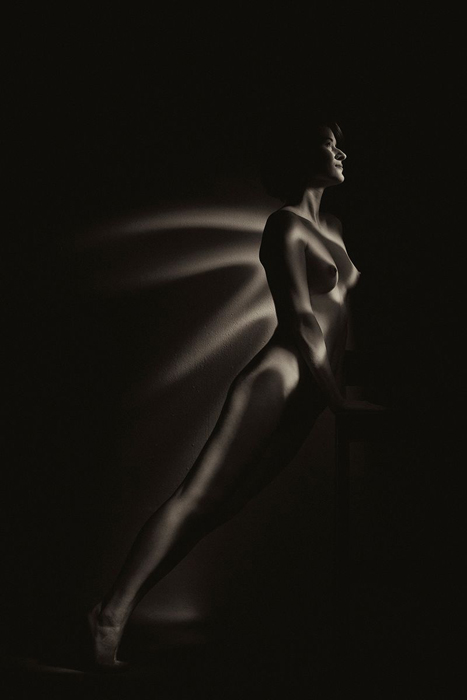
I had a lot of trials to obtain a satisfactory result straight out of the camera.
If the photo shoot happens on a natural location, I will check out the weather conditions and on which moment the sun will appear at its best. I always inspect how the location looks like and what can be done with the background.
Which are your most important experiences that has influenced your art?
I learned some very hard lessons when models didn’t show up or cancelled just an hour before the should would start. So, I rented a studio, stole family time, organises my work and business trips just for nothing.
My advice is not to invest too much in a first photoshoot, when working with new models or models without recommendations, don't invest to much in a first photo shoot. If a model gets my full confidence, then I will invest into more expensive and difficult photo shoots.
For example, into underwater photo shoot:
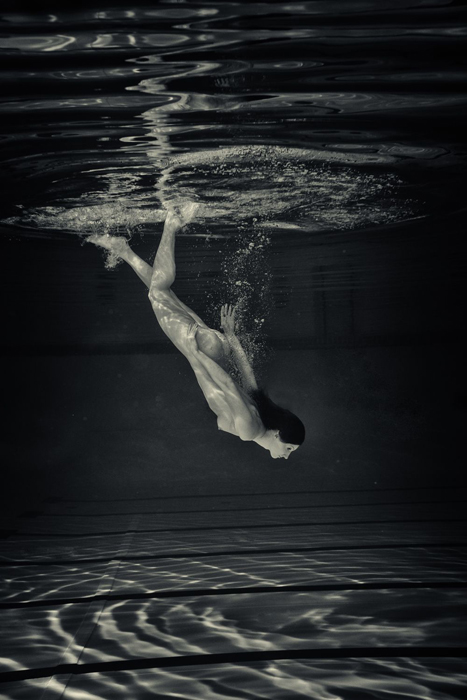
As for a photo shoot with animals, we must understand each other very quickly as the scene is changing very fast.
Another essential thing is 'talking' to each other. It will save you from possible misunderstandings.
A lot of models refuse to pose for creative photography. They just wanted lovely pics for social network without any efforts required from the model.
Never hide your intentions if you want tot publish results of your photoshoot.
As William Mortensen noticed 100 years ago: if you are honest with your models and they don't agree you to decide what you will do with the photographs, don't even start as it will lead to lost energy and wasted time.
What gear do you use (camera, lenses, bag)?
I'm using Nikon cameras since 2007 after a friend suggested to buy a second-hand Nikon D70s camera for a good price.
When the shutter died after few years, I bought a second-hand Nikon D200.
Step by step I learned all I could get out of my gear, trying to constantly improve my skills. Well, the Nikon D200 shutter died in middle of a fine art photo shoot in a frozen waterfall. Since 2013 I’m using Nikon full frame cameras.
I like to work with prime lenses as I love to shoot during the golden hour or when there is very little light. My favourite lens for the studio is an 85mm lens, but outdoors my favourite is the 135mm lens. With those two lenses I can create the majority of my works. As I love interesting bokeh and sun flares, I also have a collection of some manual lenses.
This image was created with my 6 years old camera:
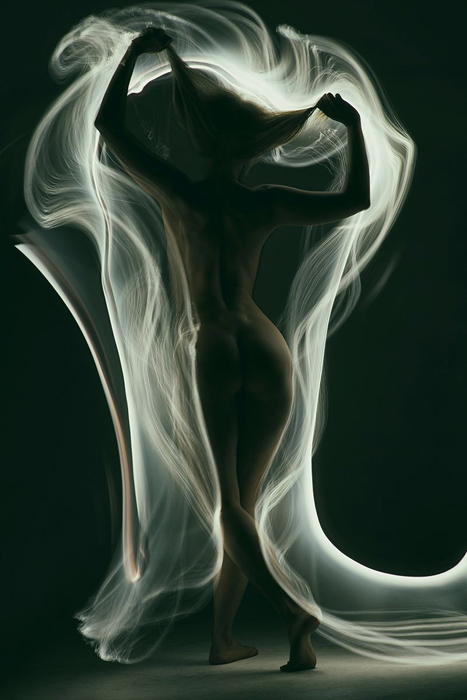
I'm convinced that I won’t create better by using an expensive camera.
What software do you use to process your images?
Can you tell us something more about your work flow?
I try to be lazy by making good images straight out of the camera. If I see potential, I rank the images during the photo shoot, which makes the selection on the computer much easier. Sometimes models advise for some specific works when checking them on the camera, so I mark those too.
I’m post processing all my images in Adobe Photoshop. The basic adjustments like exposure, contrast, colour temperature, are done in Camera RAW. Final part is done in Photoshop, like colour adjustments, film grain, textures, black and white and sometimes some filters. I don't use any pre-set packs and Lightroom.
Describe your favourite photograph taken by you and why it is special to you?
It is difficult to show just one picture as a lot of pictures have stories and memories.
When shooting models by using flour (2013-2015) I want to show beauty and at the same time, dynamic and movement. This project gave me a lot of experience, it was my first solo exhibition. One of my favourite work from series:
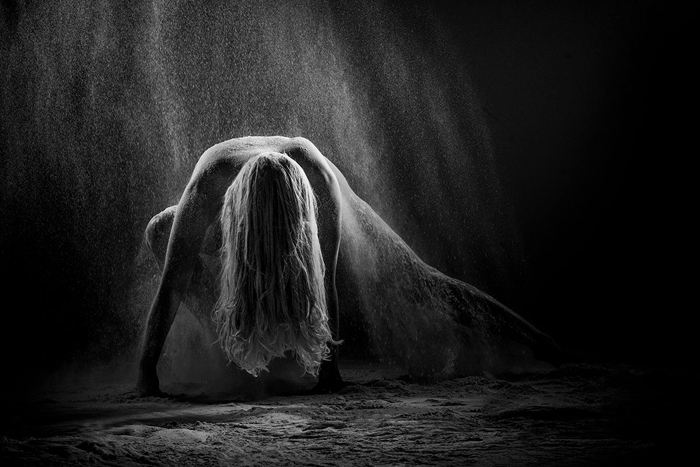
This work has been chosen as winner for a competition and was published in a calendar. Later on it was rewarded in photo contests and exhibitions.
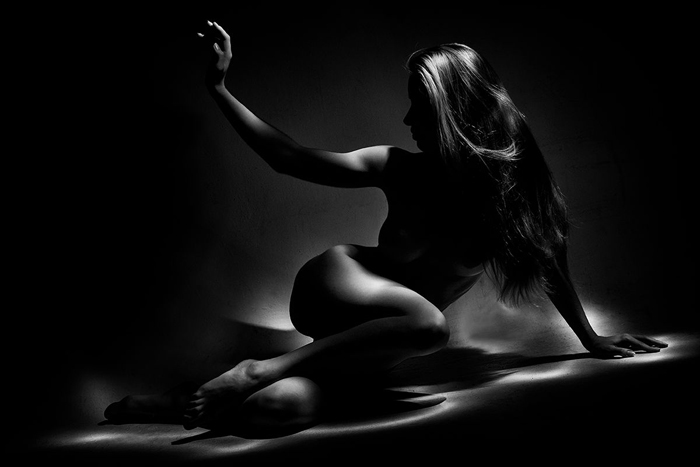
This image is from the first years when I started experimenting with light painting.
This was a very special photo shoot which gave the model a lot of confidence. This model had to deal with the jealousy of her boyfriend. An incredible drama started, lots of crying and shouting right after we finished. She wrote me a letter later telling that she could now imagine how males can be weak and miserable. She ran into the usual trap with an oppressing boyfriend. But we both were happy and proud regarding the result.
Another image from my early light painting period with a story behind is
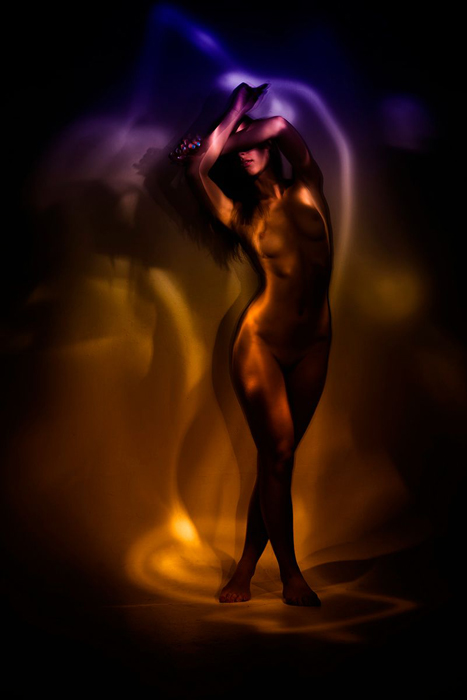
The model from this image – Julia Zu - noticed my work on the internet wanted to pose for me as to make her first steps into her model career. Unfortunately, she was only 17 and I never take pictures of under aged models. After a long conversation, I told her that when she reached the age of 18, we would have the photo shoot if she was still interested. After our first photo shoot, she gained a lot of confidence and started posing for more photographers. Nowadays, she is an international travelling model.
My first multi exposure photography was taken in October 2014 for a series I'm still working on. It is a series in which the human body is in symbiosis with nature. My very first multiple exposure shot required more than 80 shutter clicks to figure out about the basics of multi-exposure photography.
Some models who initially refused my offer to pose but reviewed my works later on, understand my aim for creative art. I'm always happy with long term collaborations.
This image is from a night photo shoot in the summer of 2018.
Not all models will agree to go to the river at night to have a nude photo shoot – that’s why I have very few special images using light painting technique – summer is very short in Latvia.
Who are your favourite photographers and more importantly, how has your appreciation of their work affected how you approach your own photography?
When I’m travelling, I visit museums and get inspiration by enjoying paintings, sculptures and photographs. Mainly European artists. I also enjoy watching movies and series about photography to get inspired.
Of course, I get inspiration from well-known fine art photographers like Guido Argentini.
Jock Sturges is also very inspiring to me. His shots are very sensual, provocative and at the same time delicate with psycho-logic depth.
I planned to meet Anton Novozhilov (http://gobotoru.eu/) from Estonia in 2020, but unfortunately it didn't happen due to several reasons.
I would love to meet 1x member Aurimas Valevičius from Lithuania in person as he is great master.
Speaking about some very special persons, I have a huge admiration for the painter Boris Vallejo and Julie Bell. They are working with amazing models and put them in world of fantasies. Most Inspiring to me because I'm working on series with models and deer or other animals.
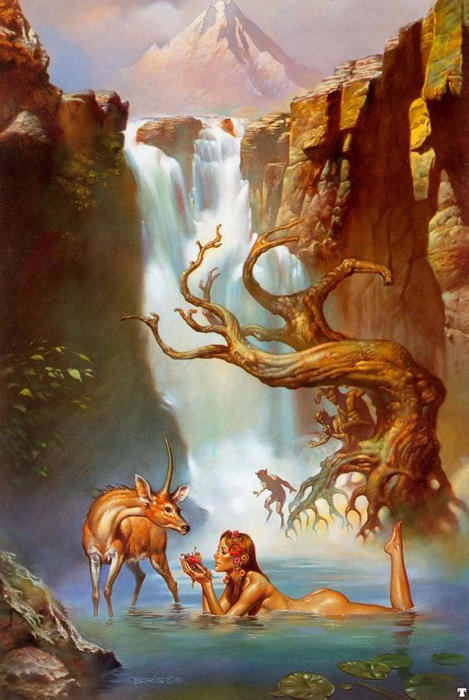
copyrights Boris Vallejo
Are there any specific directions that you would like to take your photography in the future or any specific goals that you wish to achieve?
The situation with Covid changed a lot for me. I planned several shoots for each period of the year focusing on outdoor photography, but currently I don't even check my to-do list any more. For the moment I prefer to avoid talking about my plans and dreams (much talk, little work). In my country, all photo shoots are forbidden since the middle of December. As I cannot move without serious restrictions, I'm taking nature photos to add to my double exposure project – Symbiosis of the human body and nature.
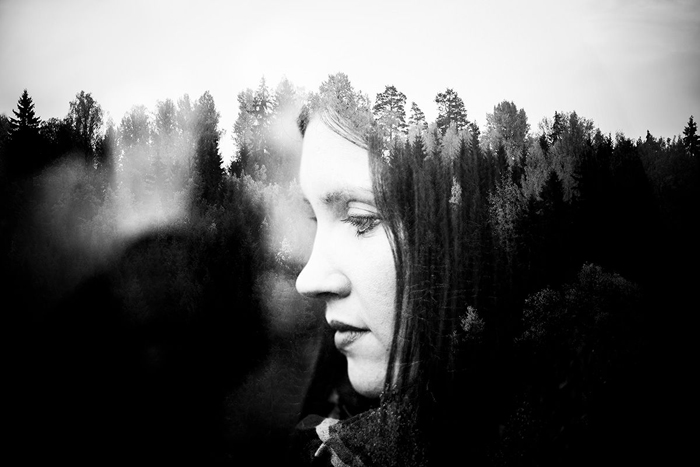
What is your most important advice to a beginner in Fine Nude Art Photography and how do you get started?
Main thing is that if you don't know what direction to go, you will most likely never arrive at your destination. Planning is a way to try to achieve it. We all love to learn from other people’s mistakes while making plenty ourselves. If you aren't satisfied, just move ahead and change something about it.
Get inspiration by checking the work of other photographers, by paintings and sculptures. Internet provides us an incredible amount of information. Watch movies, listen to music, read books. You never know what will inspire you and might give you some ideas.
Don’t focus on expensive gear. Once you will understand why you can’t make some pictures with your existing gear, you will know what gear you need. Remember that the colour of your camera strap doesn't make you create better photographs ;-)
Henri Cartier Bresson ever said: “Your first 10,000 photographs are your worst”. Well, in the age of digital cameras we should say “Your first 100,000 photographs will be the worst'.
The journey of a Fine Art Photographer is not easy as a lot of people might treat you as being weird and you will definitely will meet prejudiced people but it is such an exciting journey. May the light be with you!
Some more works below – I hope you will like them.
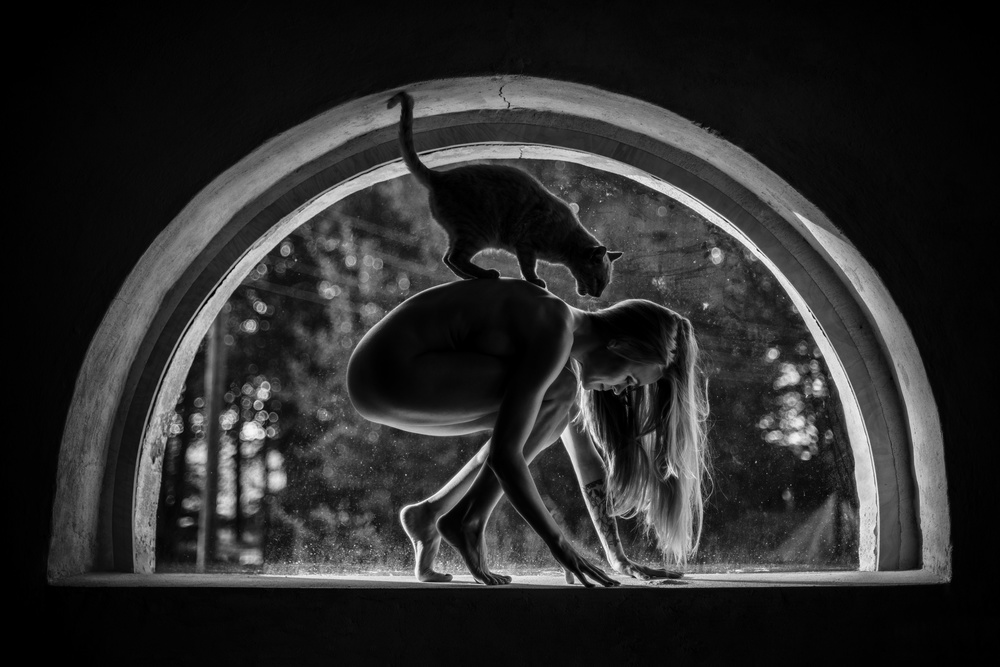
All credits to my model Svetlana Zigajeva
 | Write |
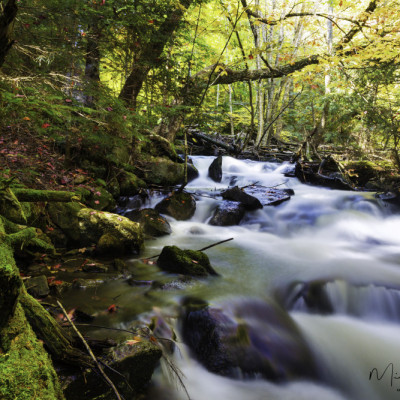 | Michael Latman Thanks for sharing your artistic view and beautiful shots. |
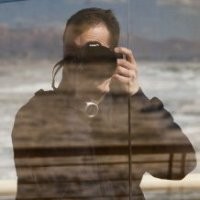 | Gianluca Morello PRO Very nice article and wonderful photos. The light painting is amazing! Congratulation Andris and Yvette! |
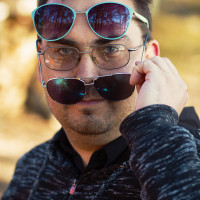 | Andris Apshenieks PRO Thanks a lot, Gianluca! |
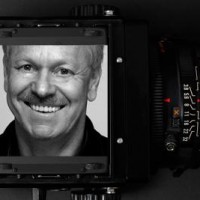 | Erhard Batzdorf PRO You have a very special creative way to show the beauty of the bodies with self designed light. Thank you for letting us understand your attitude and photographic evolution. It's really interesting and I wish you a lot of fun for your creative work.
Thanks also to Yvette for her efforts. |
 | Yvette Depaepe CREW Thank you, dear Erhard! |
 | Andris Apshenieks PRO Thank you so much! |